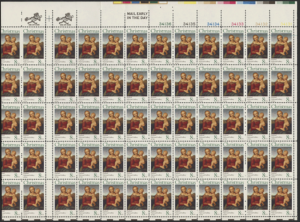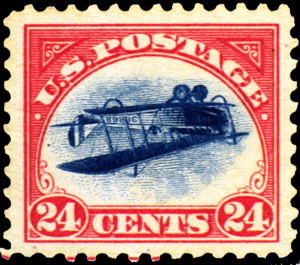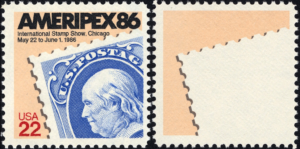Sell It Now, or Sell It Later?
The Conundrum Faced by Discoverers Of Errors
By John M. Hotchner
Note: The errors shown here are not related to the described at the beginning of this article.
A recent correspondent told me about an imperf error pane of commemoratives he bought at a post office when it was a new issue about 45 years ago. As an early, if not the first, discovery, he asked dealers what they would pay for it, and received a $20,000 offer for  the imperf pane of 50 stamps.
the imperf pane of 50 stamps.
To make a long story short, he rejected the offer; thinking that time and scarcity would push the price up. He still owns the pane.
Time passes, and in the last year he has had a medical diagnosis that will eventually result in his being in a long-term care facility. He is looking into selling this and other stamps from his collection to help finance the cost of long-term care.
So, he contacted me to see what his wonderful find might be worth today; hopefully much more than it would have brought 45 years ago. What do you think your answer would be?
Regrettably, the news is not good. And there are several reasons why. Let me summarize them:
- The degree of rarity is down.The Scott U.S. Errors Catalogue notes that 85 to 100 pairs are now known. So at least four imperf panes of 50 have come to light. While the original offer would have been equivalent to $800 per pair in 1977 dollars, the current catalogue price is $700 per pair.
- If errors were selling at catalogue, that would be in the ballpark compared to the
 original offer, but they typically sell for 35 to 50 percent of catalogue at auction; and there are not many collectors of full imperf panes, if any. Thus, potential buyers would almost certainly be limited to dealers, and not many of them. A dealer would now offer a good deal less than even auction value as the pane would have to be broken up, and it would take significant time to retail enough of the pane to recover the cost before the dealer could expect to make a profit. And as a significant new group of the errors came on the market, the price per pair would tend to drop as potential bidders got their needs.
original offer, but they typically sell for 35 to 50 percent of catalogue at auction; and there are not many collectors of full imperf panes, if any. Thus, potential buyers would almost certainly be limited to dealers, and not many of them. A dealer would now offer a good deal less than even auction value as the pane would have to be broken up, and it would take significant time to retail enough of the pane to recover the cost before the dealer could expect to make a profit. And as a significant new group of the errors came on the market, the price per pair would tend to drop as potential bidders got their needs. - Demand is basically unknown as the popularity of error collecting has diminished somewhat since the “good old days” when Jacques C. Schiff, Jr. and others held regular auctions with significant EFO [Errors, Freaks and Oddities; see John’s previous VSC column] content, and there was much more buzz in the philatelic press about new finds.
- These days, the quality of printing has improved and not only are there fewer errors being discovered, but those that are identified in the printing process are more likely

The Legends of the West sheet in 1994 was recalled, after it was discovered that the image of Bill Picket, left, was really that of his brother Ben. The sheet was then reissued with Bill’s picture, but some of the mistakes had been sold.
to be caught and destroyed by the improved electronic quality control equipment that has been installed on modern production equipment.
- The real value of the dollar has dropped like a stone at the average inflation rate of 2.9% over the 40+ years. What this means is that it now takes $3.41 to buy what a 1980 dollar would have purchased then. Apply this to the prices cited above, and it is clear that the owner of the pane would have to sell the pane for over $68,000 today just to keep up with inflation.
So, what lessons can we take away from this parable? First, if you turn down a significant offer for a newly discovered philatelic item, you are betting that no more, or only a few more, will be discovered. That would be a requirement as a basis for your find gathering
more value as the years march on. Also, you also need to pray that the rate of inflation is not going to eat up the potential increase in value.
As you consider an offer, you need to think about the popularity of the hobby; whether it is going to increase or decrease over the period of time you project holding the error in your collection. A complicating factor to this is whether your error fits into one of the increasingly popular topics (like Space Exploration, Animals, or American Indians) that tend to hold their value better than many other stamp subjects. This is because topical/thematic stamp collecting is often the method of choice for people coming into the hobby.
 Please understand that I am not saying a find should always be sold immediately. It can and does happen that no more or only a few more will be found; that the initial public announcement will spark a frenzy among collectors, and maybe even coverage in the nonphilatelic press. The price could rise to dizzying heights.
Please understand that I am not saying a find should always be sold immediately. It can and does happen that no more or only a few more will be found; that the initial public announcement will spark a frenzy among collectors, and maybe even coverage in the nonphilatelic press. The price could rise to dizzying heights.
How often does this happen? A lot depends upon the nature of the error. Inverts seem to capture the public eye. Full panes of imperfs or missing colors, not so much. Foldovers that contain one or a few missing color errors or imperfs are more likely to acquire and hold value.
But items that gather substantial value are relatively few, and I can cite many stories of people who sold rapidly and did much better than they would have had they held on for a lengthy period as many more examples surfaced. So, one must consider all the factors noted above, and then make the best decision you can, knowing what you know — and what you don’t know — in the moment.
Just remember the old saying, “Act in haste; repent at leisure.”
Should you wish to comment on this column, or have questions or ideas you would like to have explored in a future column, please write to John Hotchner, VSC Contributor, P.O. Box 1125, Falls Church, VA 22041-0125, or email, putting “VSC” in the subject line.
Or comment right here.




